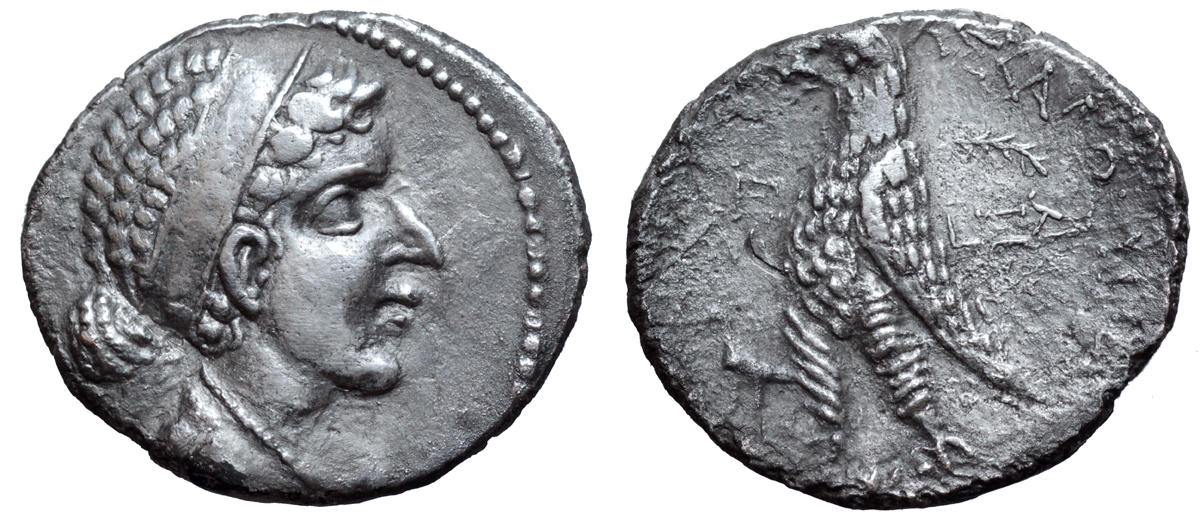Ascalon (Cleopatra), silver, tetradrachms (Cleopatra/standing eagle) (49-38 BCE)
From SILVER
(Redirected from S 1892 - Ascalon (Cleopatra), silver, tetradrachms (49-38 BCE))
49 BCE - 38 BCE Silver 3,566 kg
Description
| ObverseInscription or printing placed on the obverse.: | Diademed bust of Cleopatra right, wearing necklace, hair plaited in rows and tied at back in a chignon |
| ReverseInscription or printing placed on the reverse.: | ΙΕΡΑΣ ΑΣΥΛΟΥ ΑΣΚΑΛΩΝΙΤΩΝ (Sacred and Inviolate of (the people of) Askalon) (Greek).Eagle standing to right, palm over left wing, monogram and dove to left, LΞΔ to right |
Mint and issuing power
| MintIdentifies the place of manufacture or issue of a numismatic object.: | Ascalon | Ancient regionAncient region.: | Phoenicia | Modern countryModern country: Israel | AuthorityIdentifies the issuing power. The authority can be "pretended" when the name or the portrait of X is on the coin but he/she was not the issuing power. It can also be "uncertain" when there is no mention of X on the coin but he/she was the issuing power according to the historical sources: | Cleopatra VII Philopator (Ptolemaic queen, 51-30 BC), Ptolemaic dynasty (323-30 BC) |
Chronology
| FromIdentifies the initial date in a range assigned in a numismatic context. | 49 BCE | toIdentifies the final date in a range assigned in a numismatic context.. | 38 BCE | PeriodTime period of the numismatic object.: Hellenistic 323-30 BC |
Physical description
| MetalThe physical material (usually metal) from which an object is made.: | Silver |
Median weightMedian of the weights of numismatic objects (in grams). in grams | 12.80 | DenominationTerm indicating the value of a numismatic object. Examples: tetradrachm, chalkous, denarius.: | tetradrachm |
StandardStandard.: | Ptolemaic |
Image

S1892 Ascalon tetradrachms Cleopatra.jpg [1]
References
| Die study referencePublication of the study: | Gitler - Master 20101Gitler - Master 2010, p. 85-86 | ||
| Coin series referenceReference to coin series study: | Sear II2Sear II, n° 6077 | ||
| Coin series web referenceCoin series web references: | |||
Obverse dies distribution
| FrequencyFrequency of specimen in distribution. ᵖ | Number of obversesNumber of obverse dies. ᵖ (o) | % (o) | Number of coinsNumber of coins. (n) | % (n) | Die nameName(s) of the die(s). |
| 1 | 4 | 80 | 4 | 57.14 | 1, 2, 3, 5 |
| 3 | 1 | 20 | 3 | 42.86 | 4 |
| Total | 5 of 5 | 100 | 7 of 7 | 100 |
Reverse dies distribution
no distribution is available
Quantification
| Number of obversesNumber of obverse dies. ᵖ (o) | 5 | Number of singletons (o1)The number of singleton coins. ᵖ | 4 |
| Number of reverse diesNumber of reverse dies. (r) | 7 | Number of coinsNumber of coins. (n) | 7 |
| Coins per obverse dieNumber of coins per obverse die. (n/o) | 1.4 | Coins per reverse dieNumber of coins per reverse die. (n/r) | 1 |
| Reverse per obverse ratioRatio of obverse dies divided by reverse dies. (r/o) | 1.4 | Percentage of singletons (o1)number of coins (n) divided by the number of singletons (o1) ᵖ | 80 % |
| Original number of dies (O) (Carter 1983 formula)The estimation of the number of coins according to Carter 1983 ᵖ | 13.93 | Coins struck if 20,000 as average productivity per dieCoins made if the average productivity for obverses (according to Carter) is 20,000. ᵖ | 278,600 |
| Original number of dies (O) (Esty 2011 formula)The estimation of the number of coins according to the singleton formula in Esty 2011 ᵖ (O) | 17.5 | Survival rate if 20,000 as average productivity per dieSurvival rate if average productivity is 20,000. ᵖ | 0.00003 |
| Coverage (o = % of O) (Esty 1984 formula)Esty 1984 - coverage (% of O) ᵖ (o = % of O) | 42.86% | Die productivity if survival rate 1/2,000Average productivity if survival rate is 1/2,000. ᵖ | 1,005.03 |
| Weight of silver (in kg) if 20,000 coins per die (O = Carter formula)Carter 1983 * Median weight * 20000 (*10 if gold or electrum) ᵖ | 3,566 kg <br /> 3,566 kg | Die productivity if survival rate 1/5,000Average productivity if survival rate is 1/5,000. ᵖ | 2,512.56 |
Remarks
Most likely one single workstation